Nellah Massey Bailey facts for kids
Quick facts for kids
Nellah Massey Bailey
|
|
|---|---|
 |
|
| Mississippi State Tax Collector | |
| In office January 19, 1948 – March 31, 1956 |
|
| Governor | Fielding L. Wright Hugh L. White James P. Coleman |
| Preceded by | Carl Craig |
| Succeeded by | William Winter |
| First Lady of Mississippi | |
| In role January 18, 1944 – November 2, 1946 |
|
| Governor | Thomas L. Bailey |
| Preceded by | Clara Murphree |
| Succeeded by | Nan Wright |
| Personal details | |
| Born |
Nellah Izora Massey
June 30, 1893 Birmingham, Alabama, U.S. |
| Died | March 31, 1956 (aged 62) Meridian, Mississippi, U.S. |
| Political party | Democratic |
| Spouse |
Thomas L. Bailey
(m. 1917; died 1946) |
| Children | 2 |
Nellah Izora Massey Bailey (born June 30, 1893 – died March 31, 1956) was an important American politician and librarian. She was the first lady of Mississippi from 1944 to 1946. Later, she became the Mississippi state tax collector from 1948 to 1956. As a member of the Democratic Party, she made history as the first woman elected to a statewide office in Mississippi.
Nellah was born in Birmingham, Alabama. She studied library science in Chautauqua, New York, and worked at the public library in Meridian, Mississippi, for 30 years. In 1917, she married Thomas L. Bailey, who would later become the governor of Mississippi. As the First Lady, she led a special campaign during World War II. This campaign encouraged women in Mississippi to join the United States Armed Forces.
In 1947, Nellah Bailey decided to run for Mississippi state tax collector. She won the Democratic primary election and then ran unopposed in the general election. This meant she was the only candidate. She was re-elected two more times, in 1951 and 1955. Sadly, she passed away just three months into her third term after having several heart attacks.
Contents
Early Life and Education
Nellah Izora Massey was born on June 30, 1893, in Birmingham, Alabama. Her father, Charles Carter Massey, was a firefighter in Birmingham. Her mother was Jessie Irene Massey. In 1913, her family moved to Meridian, Mississippi, because her father became the assistant chief of the Meridian fire department.
After finishing school at Meridian High School, Nellah went to library school in Chautauqua, New York. She also completed an apprenticeship, which is like on-the-job training, in library work back in Birmingham.
Library Career and Family Life

In 1913, Nellah returned to Meridian to work as an assistant librarian at a new Carnegie library. This library was one of two libraries opened that year in Meridian with money from a generous person named Andrew Carnegie. She became the head librarian in 1934 and stayed in that job until 1943. After that, she moved to Jackson.
Nellah was also involved in many women's groups. In 1932, she became the president of the Meridian Pilot Club. This was a local part of Pilot International, an organization similar to Rotary International. She even became the president of Pilot International from 1936 to 1937. She was also a founding member of the Business and Professional Women's Clubs in Mississippi. For eight years, she led the Lauderdale County chapter of the March of Dimes, which raised money for health causes.
Nellah met her future husband, Thomas Lowry Bailey, while working at the Meridian public library. He was an attorney helping judge a local word contest. Nellah would keep the library open late so the judges could use the encyclopedias. Thomas started staying later to help Nellah close the library. They began dating and got married on August 22, 1917.
They adopted a son, Harold Melby Bailey, who was born in 1922 or 1923. They also had a daughter, Nellah Pope Bailey, born in 1925 or 1926.
First Lady of Mississippi (1944–1946)
The Baileys moved into the Mississippi Governor's Mansion in Jackson on January 9, 1944. Nellah Massey Bailey became the first lady of Mississippi when Thomas Bailey became governor on January 18, 1944. She served in this role until Governor Bailey passed away on November 2, 1946. He died from complications after surgery to remove a spinal tumor.
Leading Women's Recruitment During World War II
In March 1944, during World War II, Nellah Bailey became the state leader for a new campaign in Mississippi. This campaign was called the Mississippi Joint Recruitment Campaign. Its goal was to find women across the state who could join the four women's branches of the United States Armed Forces. These branches included the Women's Army Corps and the Navy Women's Reserve (called the WAVES).
The campaign's main purpose was to give information to women interested in joining the military. It was not to force them to join. Nellah believed that women had a duty to help in the war. She said it was an honor for young women to serve their country. She also argued against the idea that women would become "less feminine" after serving. Instead, she believed they would gain "poise and character."
As the state leader, Nellah appointed a committee of important leaders from different groups. Mayors across the state were asked to create local committees to help with the campaign. The program was very popular and was extended. An official from the national Office of Civilian Defense said that Mississippi had "blazed the trail" for recruiting women. This campaign was the first of its kind in any state.
Mississippi State Tax Collector (1948–1956)
Many people thought Nellah Bailey would run for a statewide office. In January 1947, she was even considered for a possible U.S. Senate seat, but she did not comment on it.
The person who was the state tax collector, Carl Craig, announced he would run for a different job. So, on May 17, 1947, Nellah Bailey officially entered the race for state tax collector. She was the first woman ever to run for a statewide office in Mississippi. She campaigned using her late husband's name, as "Mrs. Thomas L. Bailey." She said she wanted to be part of the government to help achieve the goals her husband had for Mississippi.
Two other men also planned to run for state tax collector. But when they learned Nellah Bailey was running, one of them, Potts Johnson, dropped out and supported her. He said that if men ask women to vote for them, then women should also be able to hold important state jobs. He believed a woman could do the tax collecting job just as well as a man.
Nellah Bailey won the Democratic primary election with 60.5 percent of the votes. She then ran unopposed in the general election, meaning she had no opponents. On January 19, 1948, she was sworn in as state tax collector. This made her the first woman to hold a statewide elected office in Mississippi.
Her Time in Office and Re-elections
During Nellah Bailey's time as state tax collector, taxes on certain goods were a big part of her job. Even though some sales were illegal, the state collected a "black market" tax on them. During her term, the money collected from these taxes reached very high levels. The tax collector's office received a percentage of all the taxes collected. This made it a very profitable elected position in the state.
In April 1951, two men challenged Nellah Bailey for the state tax collector position. One of them, C. W. Pitts, wanted to get rid of the "black market" tax. The other, Robert W. May, criticized Nellah for relying too much on her assistants. Pitts even said the job should be "a man's job." Nellah responded by explaining that the money collected was shared among the 17 employees in her office.
Nellah Bailey won the Democratic primary election again, getting 54.4 percent of the votes. This meant she didn't need a second election (a runoff). She had no opponents in the general election and started her second term on January 21, 1952.
In 1955, four candidates ran for state tax collector in the Democratic primary. Nellah Bailey received 44.8 percent of the votes. Since no one got more than half the votes, she had to go to a runoff election against Howard H. Little. Even though the other two candidates supported Little, Nellah Bailey won the runoff election by a small margin.
Death and What She Left Behind
Just three months into her third term as state tax collector, Nellah Bailey suffered several heart attacks. She passed away at age 62 on March 31, 1956, at Riley Memorial Hospital in Meridian. Her funeral was held on April 2, 1956, and she was buried in Magnolia Cemetery.
After her death, a close friend, state representative Betty Jane Long, introduced a special resolution to honor Nellah. The Clarion-Ledger newspaper wrote that many women in Mississippi were proud of her achievements. They hoped her example would inspire other women to run for office.
There was a lot of talk about who Governor James P. Coleman would choose to replace Nellah in the important tax collector job. Governor Coleman eventually appointed state representative William Winter to finish her term. Winter was the last person to hold the office of state tax collector. The job was officially ended in 1964, based on his recommendation.
A painting of Nellah Bailey, given by her grandson Thomas Webb, has been on display at the Old Capitol Museum in Jackson since 2019.
Images for kids


